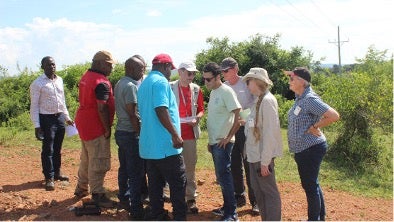
An IAEA Integrated Uranium Production Cycle Review (IUPCR) team has completed an inaugural review of a uranium production cycle at the request of the Ugandan government. The mission assessed Uganda’s capabilities to develop their uranium exploration programme and eventually mine uranium for a domestic nuclear power programme.
Uganda is looking to use nuclear power as part of its plan to meet its clean energy goals and increase access to electricity for its population of nearly 50m. Currently only around half of Ugandans have access to electricity, but the government has targeted an electricity access rate of more than 99% by 2030. Uganda is aiming for nuclear power generation by 2031 using domestically sourced uranium.
This first ever IUPCR mission, conducted with the support of the IAEA’s technical cooperation programme, evaluated the status of the infrastructure Uganda will need to support uranium exploration, the first phase of a uranium production cycle programme. The mission involved 82 participants, primarily from Uganda’s Ministry of Energy & Mineral Development and included a field visit to a site where exploration activities have been taking place.
The mission team, including experts from Argentina, Australia, France, Namibia and the IAEA, reviewed the status of 16 key aspects, including human resource capacity and the regulatory framework, and recommended steps that can be taken to bring the country closer to realising its nuclear energy goals, which include a domestic supply of uranium.
“The potential discovery of a uranium deposit and subsequent development of uranium resources in Uganda presents an exciting opportunity for the country to support its ambition to introduce nuclear power into its energy mix,” said Adrienne Hanly, the IAEA’s Technical Lead for Uranium Resources and Production. “While significant work remains to be done, the Ministry of Energy and Mineral Development now has a solid understanding of what is required to succeed in evaluation of the country’s uranium occurrences and the next steps needed to get there.”
Several areas in Uganda have been identified as potentially uranium-rich, though no proven resources have been identified as yet. Exploration practices to make a final determination involve activities such as radiometric surveys and taking geochemical samples.
“The government of Uganda is committed to adopting international best practices and this IAEA mission will ensure uranium exploration is done according to international standards,” said Ruth Nakabirwa Sentamu, Uganda’s Minister of Energy and Mineral Development.
The IUPCR team made several recommendations to facilitate the success of the exploration programme. These included that Uganda should ensure the development of skilled personnel for uranium exploration and that the discovery, assessment and development of potential uranium resources are accelerated by establishing a robust and well-funded exploration programme.
The mission was implemented as part of a four-year IAEA Technical Cooperation Project on supporting uranium exploration and evaluation, which began in 2022. Uranium exploration is highlighted as an important priority in Uganda’s new Country Programme Framework for the 2024-2029 period. “We are very supportive to strengthening the technical capacity of the Directorate of Geological Survey and Mines to explore and evaluate Uganda’s uranium occurrences in terms of skills development and exploration tools,” said Anna Grigoryan, IAEA Programme Management Officer for Uganda.






